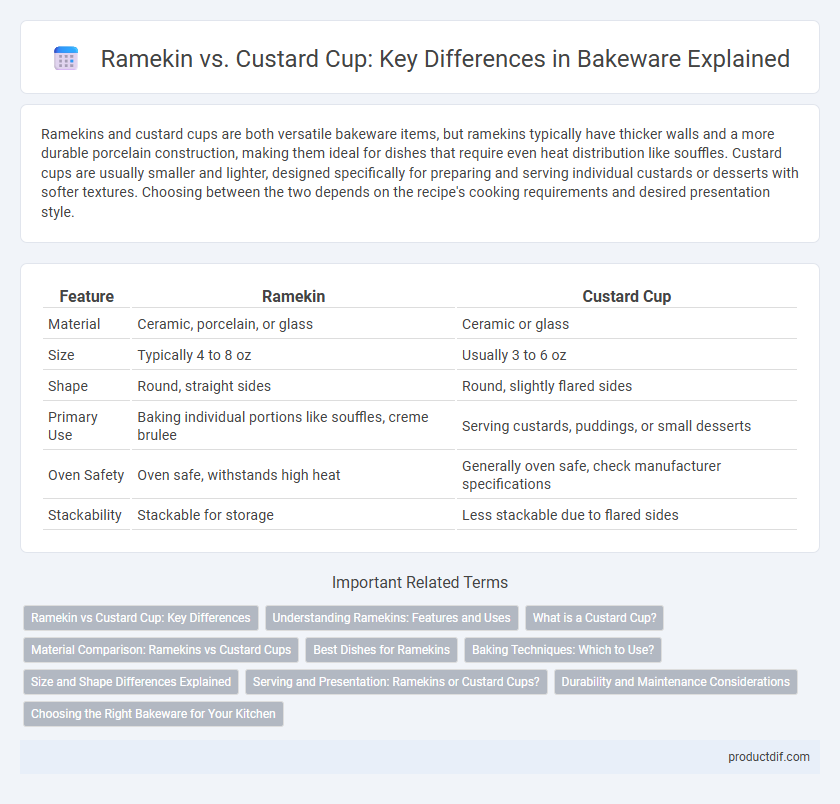Ramekins and custard cups are both versatile bakeware items, but ramekins typically have thicker walls and a more durable porcelain construction, making them ideal for dishes that require even heat distribution like souffles. Custard cups are usually smaller and lighter, designed specifically for preparing and serving individual custards or desserts with softer textures. Choosing between the two depends on the recipe's cooking requirements and desired presentation style.
Table of Comparison
| Feature | Ramekin | Custard Cup |
|---|---|---|
| Material | Ceramic, porcelain, or glass | Ceramic or glass |
| Size | Typically 4 to 8 oz | Usually 3 to 6 oz |
| Shape | Round, straight sides | Round, slightly flared sides |
| Primary Use | Baking individual portions like souffles, creme brulee | Serving custards, puddings, or small desserts |
| Oven Safety | Oven safe, withstands high heat | Generally oven safe, check manufacturer specifications |
| Stackability | Stackable for storage | Less stackable due to flared sides |
Ramekin vs Custard Cup: Key Differences
Ramekins are typically smaller, thicker-walled ceramic dishes designed for individual portions and can withstand high oven temperatures, making them ideal for souffles and creme brulee. Custard cups are usually thinner, more delicate, and sometimes made from glass or porcelain, primarily used for serving custards and puddings rather than baking. The key differences lie in size, material durability, and intended culinary use, with ramekins suited for baking and custard cups mainly for serving.
Understanding Ramekins: Features and Uses
Ramekins are small, cylindrical ceramic dishes designed to withstand high oven temperatures, making them ideal for individual portions of baked dishes like souffles, creme brulee, and custards. Their thick walls promote even heat distribution, ensuring consistent cooking and a perfect texture. Unlike custard cups, ramekins often feature smooth or fluted sides and come in various sizes, enhancing versatility for both sweet and savory recipes.
What is a Custard Cup?
A custard cup is a small, heat-resistant ceramic or glass dish designed for baking and serving individual portions of custards, puddings, and other desserts. Typically featuring straight sides and a capacity ranging from 4 to 8 ounces, custard cups ensure even cooking and easy portion control. Its durable construction withstands oven temperatures, making it ideal for both baking and presentation.
Material Comparison: Ramekins vs Custard Cups
Ramekins are typically made from durable stoneware or ceramic that withstands high oven temperatures and provides even heat distribution, making them ideal for baking individual portions. Custard cups are often crafted from porcelain or glass, offering a smooth surface for delicate desserts but sometimes less heat retention compared to stoneware. Both materials offer oven-safe options, but stoneware ramekins excel in durability and thermal stability, while porcelain custard cups are favored for elegant presentation.
Best Dishes for Ramekins
Ramekins are ideal for individual servings of baked dishes such as souffles, creme brulee, and molten lava cakes due to their heat-resistant ceramic material and consistent shape. Their small size and depth make them perfect for portion-controlled desserts and savory dishes like pot pies or baked eggs. Unlike custard cups, ramekins offer superior heat retention and an elegant presentation, enhancing both baking performance and dining experience.
Baking Techniques: Which to Use?
Ramekins and custard cups differ significantly in size and heat distribution, affecting baking outcomes. Ramekins, typically thicker and smaller, provide even heat for delicate dishes like souffles requiring precise rising, while custard cups are thinner and larger, better suited for gentle baking of custards and puddings with slower, uniform cooking. Choosing the right bakeware based on thickness and capacity ensures optimal texture and cooking performance in recipes.
Size and Shape Differences Explained
Ramekins typically measure between 4 to 8 ounces with straight, flared sides ideal for even heat distribution, while custard cups range from 3 to 6 ounces featuring a more rounded shape that helps retain creamy textures. The taller, cylindrical form of ramekins promotes quicker baking, whereas the shallow, wider design of custard cups enhances surface area for caramelization. These size and shape differences directly impact cooking times and the consistency of dishes like souffles and creme brulee.
Serving and Presentation: Ramekins or Custard Cups?
Ramekins offer a sophisticated and uniform presentation ideal for individual souffles, creme brulee, and other delicate desserts, enhancing the visual appeal with their classic straight sides and smooth finish. Custard cups, often smaller and more versatile, provide a rustic charm suitable for puddings and baked eggs, making them perfect for casual serving settings. Choosing between ramekins and custard cups depends on the desired aesthetic and portion size, with ramekins favored in fine dining and custard cups popular for homestyle presentations.
Durability and Maintenance Considerations
Ramekins are typically made from heavy-duty ceramic or stoneware, offering superior durability and resistance to chipping compared to custard cups, which are often made from lighter porcelain or glass. The dense material of ramekins allows for better heat retention and makes them less prone to cracking during repeated oven use, while custard cups may require more careful handling and gentler cleaning methods to avoid damage. Maintenance of ramekins is simpler due to their robust construction, with most being dishwasher safe and highly resistant to staining, unlike some custard cups that may need handwashing to preserve their finish.
Choosing the Right Bakeware for Your Kitchen
Ramekins and custard cups both serve essential roles in bakeware, with ramekins typically made from thick ceramic or glass, ideal for even heat distribution in baking souffles, creme brulee, and individual casseroles. Custard cups are often smaller, more versatile, and designed for preparing custards, puddings, and serving desserts, featuring a lighter build that allows faster cooking times. Selecting the right bakeware depends on your baking needs: opt for ramekins when precise heat control and presentation are priorities, while custard cups suit quick, versatile dessert preparation.
Ramekin vs custard cup Infographic

 productdif.com
productdif.com